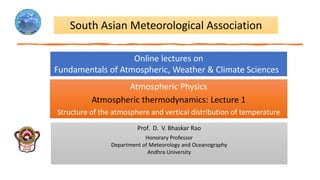The document discusses the structure and composition of Earth's atmosphere. It describes how the atmosphere is composed primarily of nitrogen and oxygen, along with smaller amounts of other gases like carbon dioxide, water vapor, methane, and ozone. It explains that temperature decreases and air pressure and density increase with decreasing altitude in the atmosphere. The vertical temperature profile is influenced by factors like lapse rates and the heating and cooling effects of different gases.
















![Vertical structure of the atmosphere
Gas constant
The gas constant for a particular gas is R = R*⁄m
The gas constant for dry air is Rd = 287 J K-1 kg-1
[molar mass of dry air = 0.028964 kg mol-1]
The gas constant for water vapor is Rv = 461 J K-1 kg-1
[molar mass of water vapour = 0.0180153 kg mol-1]](https://image.slidesharecdn.com/samal14feb2023-230603130311-7745bafb/85/SAMA_L1_4Feb2023-pptx-17-320.jpg)





































